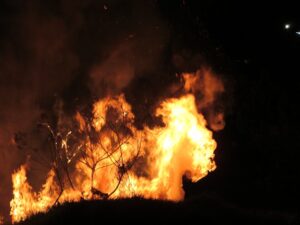Physical Address
23,24,25 & 26, 2nd Floor, Software Technology Park India, Opp: Garware Stadium,MIDC, Chikalthana, Aurangabad, Maharashtra – 431001 India
Physical Address
23,24,25 & 26, 2nd Floor, Software Technology Park India, Opp: Garware Stadium,MIDC, Chikalthana, Aurangabad, Maharashtra – 431001 India

Wildfires have spread across parts of southeastern South Korea, leading to the loss of at least 18 lives and injuries to nearly 20 people. Over 27,000 residents have been evacuated as the fires have destroyed over 17,000 hectares of forest land. Hundreds of buildings, including cultural landmarks, have been damaged. Emergency responders, including thousands of firefighters and soldiers, are working to contain the fires, but strong winds and dry conditions have made the task challenging. Authorities continue to assess the impact and coordinate relief efforts to protect affected communities and heritage sites.
The Unfolding Disaster
The wildfires broke out late last week in Sancheong County, Northern Gyeongsang Province, spreading quickly to surrounding regions like Uiseong County, Andong, Cheongsong, Yeongyang, and Yeongdeok counties. Blazing under strong, dry gusts of wind, the fires have ravaged over 17,000 hectares (42,000 acres) of forestland. The Korea Forest Service said firefighters were fighting at least five active fires nationwide.
In the face of the worsening crisis, authorities in stricken cities and towns have ordered evacuations, calling on people to flee for their safety. The speed with which the fires spread has outpaced firefighting operations, with thousands of soldiers and firefighters deployed to fight the blazes. Helicopters have been drafted to fight the fires, but the harsh weather conditions have hindered containment efforts.
Cultural Heritage at Risk
In addition to destroying natural terrain and residential zones, the wildfires have caused tremendous harm to South Korea’s cultural heritage. The Gounsa Temple, a 1,300-year-old Buddhist temple in Uiseong, has been torched by fire. The historic site, constructed in 681 AD, housed many national treasures, which authorities were able to evacuate to safe zones before the temple’s destruction.
Furthermore, the Hahoe Folk Village in Andong, a UNESCO World Heritage Centre famous for its ancient Korean homes and cultural value, was about to be destroyed as the blazes intensified. Emergency notices were raised, and rescue teams were deployed to safeguard the village, around 8 kilometers (4.9 miles) from the oncoming blazes.
Government Response and Ongoing Challenges
South Korea’s interim President, Han Duck-soo, has admitted the seriousness of the situation, saying that the wildfires have inflicted “unprecedented damage” and are “writing the record books for the worst wildfires in our country’s history.” He emphasised mobilising all available means to fight the fires and support the affected populations.
Despite the joint efforts of rescue services, the union of powerful winds and dryness remains a significant difficulty in putting out the fires. The government issued the highest-level wildfire warning and declared the worst-hit regions disaster areas to speed up recovery efforts. Authorities also investigated possible man-made causes of fires, including burning vegetation to clear thick grass and sparks from welding operations.
While South Korea is facing this catastrophic crisis, the people’s resilience and unity can still be seen. People are uniting at the community level to help each other, and programs to save and preserve the country’s cultural heritage continue in the face of the current emergency.
References:
https://www.bbc.com/news/articles/c1lp365pd1go
https://www.cnn.com/2025/03/25/asia/south-korea-wildfires-temple-destroyed-intl-hnk/index.html
https://www.theguardian.com/world/2025/mar/26/south-korea-fires-andong-city-death-toll
Banner image:
Photo by Henrique Malaguti on Unsplash